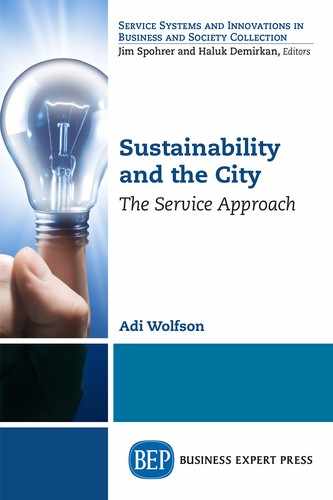Cities are without a doubt one of the miracles of human creation and the embodiment of the human environment. As such, cities—the manifestation of human imagination and skills—comprise synthetic materials and artificial technologies and provide human services. Insofar as they are large and densely populated human settlements with defined legal and political boundaries that comprise clusters of buildings, open spaces, public facilities, and infrastructure, cities are mainly spaces of services that are exchanged between a wide variety of stakeholders—namely, residents, traders, visitors, and the city authorities. In addition, as today more than 50 percent of the world’s population lives in urban areas, a proportion that will grow tremendously in the coming decades, and as most economic and social activities are performed in cities, the effect of cities’ services on sustainability as practiced by their residents as well as by the whole world should be studied and designed. Moreover, municipal services should comprise environmental, social, and economic values, which are designed, produced, and delivered in concert by the municipal authorities, residents, businesses, and visitors.
This book begins by outlining the history and development of cities and the development of service science and sustainability science from their early days to the present, while summarizing the main paradigms, concepts, and terminologies in both fields and their reciprocal relationship. It continues by addressing the “what, who, and how” of measuring sustainability, services, and sustainable services, to manage physical and nonphysical resources and tangible and intangible values within the city, and it proposes new concepts and models such as service circularity and sustainable circles to increase the sustainability within and of cities. Finally, it also presents a new model of the service-city, including its architecture and several pertinent examples, which considers it as a platform that manages and integrates the services and systems currently provided by the city while offering additional supporting services to increase the effectiveness of the value and to achieve the goal of sustainability. In addition, it looks ahead to the next generation of municipal models and services and considers how sustainability and services will interact in the cities of the future.
I would first like to thank the series editors, Jim Spohrer and Haluk Demirkan, for offering me the opportunity to write this book. I would also like to thank Patrick Martin for editing the text and assisting me in clarifying my thoughts. At last, I want to acknowledge the generous support of Sami Shamoon College of Engineering, which enabled me to perform the in-depth research in the field of sustainable service that was necessary to complete this book.
—Adi Wolfson
